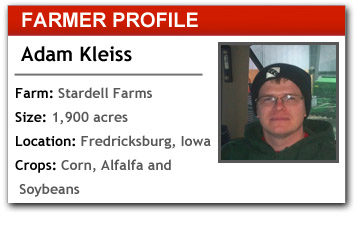 At Stardell Farms near Fredericksburg, Iowa, the Kleiss family has been able to extract some interesting results from the data produced with their precision farming technology.
At Stardell Farms near Fredericksburg, Iowa, the Kleiss family has been able to extract some interesting results from the data produced with their precision farming technology.
They farm 1,900 acres of conventionally tilled corn, alfalfa and soybeans. They also milk about 600 cows.
“We’ve had yield maps for about as long as I can remember, and started using auto-steer about 5 years ago,” says Adam Kleiss, one of the sons in the operation. “I look for precision farming tools that I can add for cheap or for free.”
Their John Deere 16-row 1770 planter is equipped with Precision Planting’s ESET system monitored by a 20/20 monitor. “That unit can produce a whole lot of data, and you have to have auto-steer to be able to stay on top of the information that it produces,” Kleiss says. They have an ATU 200 Autotrac Universal Auto-Steer system in the planter tractor.
“The right side of the planter tractor cab looks like mission control. We have six monitors for different planting systems,” Kleiss says. “One for monitoring insecticide application, another to fold and unfold the planter, the 20/20 monitor, the auto-steer system, the row cleaner monitor and the guidance system.
Kleiss would like to be able to consolidate all of the functions into one monitor and says he looks forward to the day when he can take a laptop or iPad into the tractor cab and monitor all of the systems with one device.
Point of Pain: Reliable Support
Although their planter has been equipped with pneumatic row shut-off units for 3 years, last year was the first year they were able to get them working correctly.
What Farmers Want From You is a series of farmer profiles that examine the scope of precision farming tools individual farmers are using on their operation, along with the frustrations that can occur with adopting new technology and how dealers can alleviate those "points of pain" for farm customers. For the latest additions to the series, visit our What Farmers Want From You feed.
“We had lag and lead issues. The technicians really let us down,” Kleiss says. “They kept telling us to use the auto-calibration command and that should fix it, but it didn’t. At the height of the season, we couldn’t take the time to fix it.
“We figured we planted this many years without auto row shut-off, we could do it another season.”
Last summer, Kleiss dug into the problem and talked with a friend in engineering who recommended manually calibrating the row shut-offs.
“I didn’t even know we could do that, and none of the technicians suggested it,” Kleiss says. “In the process, we also found a pinched wire to one of the units. It works great now but it was all our own work to solve this issue.”
Beyond solving calibration issues, Kleiss also wants more guidance from his precision dealer on data analysis.
“We collect lots of data, but sorting it out and interpreting it takes time,” he says. “It would be huge if the equipment dealers could help analyze the data so we can attempt to reprove it.”



![[Technology Corner] Discussing AI’s Potential Impact on Service & Support](https://www.precisionfarmingdealer.com/ext/resources/2025/04/11/Discussing-AIs-Potential-Impact-on-Service--Support.png?height=290&t=1744385717&width=400)


